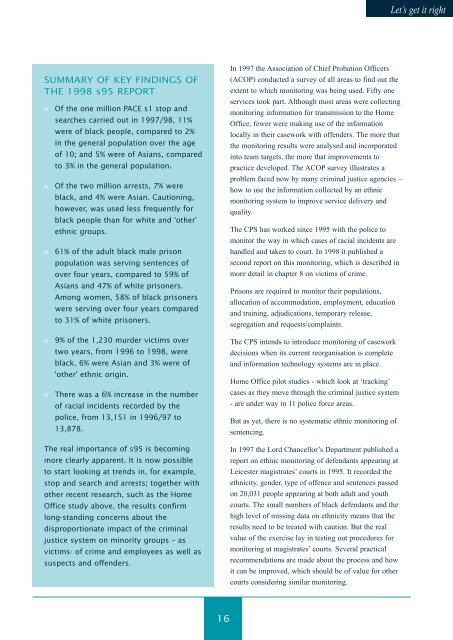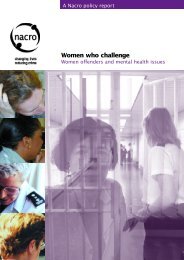Let’s <strong>get</strong> <strong>it</strong> <strong>right</strong>SUMMARY OF KEY FINDINGS OFTHE 1998 s95 REPORTnnnOf the one million PACE s1 stop <strong>and</strong>searches carried out in 1997/98, 11%were of black people, compared to 2%in the general population over the ageof 10; <strong>and</strong> 5% were of Asians, comparedto 3% in the general population.Of the two million arrests, 7% wereblack, <strong>and</strong> 4% were Asian. Cautioning,however, was used less frequently forblack people than for wh<strong>it</strong>e <strong>and</strong> ‘other’ethnic groups.61% of the adult black male prisonpopulation was serving sentences ofover four years, compared to 59% ofAsians <strong>and</strong> 47% of wh<strong>it</strong>e prisoners.Among women, 58% of black prisonerswere serving over four years comparedto 31% of wh<strong>it</strong>e prisoners.In 1997 the Association of Chief Probation Officers(ACOP) conducted a survey of all areas to find out theextent to which mon<strong>it</strong>oring was being used. Fifty oneservices took part. Although most areas were collectingmon<strong>it</strong>oring information for transmission to the HomeOffice, fewer were making use of the informationlocally in their casework w<strong>it</strong>h offenders. The more thatthe mon<strong>it</strong>oring results were analysed <strong>and</strong> incorporatedinto team tar<strong>get</strong>s, the more that improvements topractice developed. The ACOP survey illustrates aproblem faced now by many criminal <strong>justice</strong> agencies –how to use the information collected by an ethnicmon<strong>it</strong>oring system to improve service delivery <strong>and</strong>qual<strong>it</strong>y.The CPS has worked since 1995 w<strong>it</strong>h the police tomon<strong>it</strong>or the way in which cases of racial incidents areh<strong>and</strong>led <strong>and</strong> taken to court. In 1998 <strong>it</strong> published asecond report on this mon<strong>it</strong>oring, which is described inmore detail in chapter 8 on victims of crime.Prisons are required to mon<strong>it</strong>or their populations,allocation of accommodation, employment, education<strong>and</strong> training, adjudications, temporary release,segregation <strong>and</strong> requests/complaints.nn9% of the 1,230 murder victims overtwo years, from 1996 to 1998, wereblack, 6% were Asian <strong>and</strong> 3% were of‘other’ ethnic origin.There was a 6% increase in the numberof racial incidents recorded by thepolice, from 13,151 in 1996/97 to13,878.The CPS intends to introduce mon<strong>it</strong>oring of caseworkdecisions when <strong>it</strong>s current reorganisation is complete<strong>and</strong> information technology systems are in place.Home Office pilot studies - which look at ‘tracking’cases as they move through the criminal <strong>justice</strong> system- are under way in 11 police force areas.But as yet, there is no systematic ethnic mon<strong>it</strong>oring ofsentencing.The real importance of s95 is becomingmore clearly apparent. It is now possibleto start looking at trends in, for example,stop <strong>and</strong> search <strong>and</strong> arrests; to<strong>get</strong>her w<strong>it</strong>hother recent research, such as the HomeOffice study above, the results confirmlong-st<strong>and</strong>ing concerns about thedisproportionate impact of the criminal<strong>justice</strong> system on minor<strong>it</strong>y groups – asvictims- of crime <strong>and</strong> employees as well assuspects <strong>and</strong> offenders.In 1997 the Lord Chancellor’s Department published areport on ethnic mon<strong>it</strong>oring of defendants appearing atLeicester magistrates’ courts in 1995. It recorded theethnic<strong>it</strong>y, gender, type of offence <strong>and</strong> sentences passedon 20,031 people appearing at both adult <strong>and</strong> youthcourts. The small numbers of black defendants <strong>and</strong> thehigh level of missing data on ethnic<strong>it</strong>y means that theresults need to be treated w<strong>it</strong>h caution. But the realvalue of the exercise lay in testing out procedures formon<strong>it</strong>oring at magistrates’ courts. Several practicalrecommendations are made about the process <strong>and</strong> how<strong>it</strong> can be improved, which should be of value for othercourts considering similar mon<strong>it</strong>oring.16
RACE AND JUSTICE <strong>2000</strong>CHAPTER 4 RESEARCH AND ETHNICMONITORINGMon<strong>it</strong>oring categoriesThe question of which categories to use to mon<strong>it</strong>or has formany years been sens<strong>it</strong>ive <strong>and</strong> often controversial. Forexample in the probation service, the debate about whatcategories to use went on for some time <strong>and</strong> resulted in acomplex system that records both skin colour <strong>and</strong>national<strong>it</strong>y. It also records language <strong>and</strong> religion. Thereare likely to be problems w<strong>it</strong>h whatever system is used.But in the meantime, <strong>it</strong> is essential to measure the impactof the system on people from minor<strong>it</strong>y groups –particularly at key decision-making points – <strong>and</strong> to act onthe results. Any system must change <strong>and</strong> develop asthinking <strong>and</strong> knowledge develops; <strong>it</strong> must be flexible <strong>and</strong>practical; but <strong>it</strong> must also provide information.The inclusion of an ethnic origin question in the 1991Census has been invaluable in providing informationabout allocation of services, <strong>and</strong> giving a benchmarkagainst which the criminal <strong>justice</strong> system can becompared to the local population. However newcategories of Black Br<strong>it</strong>ish <strong>and</strong> Mixed Race are beingtried out in Census tests, in preparation for the 2001Census, when <strong>it</strong> is also likely that a new Irish categorywill also be used. This will have an impact for mon<strong>it</strong>oringin the criminal <strong>justice</strong> system <strong>and</strong> highlights the need forflexible <strong>and</strong> responsive mon<strong>it</strong>oring systems.A ‘four plus one’ system, based on a collapsed downversion of the 1991 Census categories, is widely used nowin criminal <strong>justice</strong> agencies: wh<strong>it</strong>e, black, Asian, other,<strong>and</strong> not known or recorded.(The 1991 Census used wh<strong>it</strong>e, Black Caribbean, BlackAfrican, Black Other, Indian, Pakistani, Bangladeshi,Chinese, Asian other, <strong>and</strong> other.)Many agencies still use their own systems – the police usetheir own IC1, 2, 3 system, for example (IC -Identification Codes) – but if whatever system used willcollapse down easily into the four plus one system, thismeans <strong>it</strong> is easier to compare trends <strong>and</strong> patterns w<strong>it</strong>hother local agencies, both locally <strong>and</strong> nationally, <strong>and</strong> w<strong>it</strong>hthe Census information. The more compatible the systemsare, the better for assessing the overall impact of thecriminal <strong>justice</strong> system.This does not prevent any local service using add<strong>it</strong>ionalmon<strong>it</strong>oring categories, based on knowledge of the localpopulation, to make sure that interpreters <strong>and</strong> otherappropriate services can be planned <strong>and</strong> bud<strong>get</strong>ed for.It is also becoming apparent that the wide category of‘Asian’ is masking important differences among theIndian, Pakistani <strong>and</strong> Bangladeshi commun<strong>it</strong>ies in termsof criminal <strong>justice</strong> <strong>and</strong>, in particular, young people.A self-classification system is best. That means asking theperson concerned to choose their own category. This isalready done in the probation service, <strong>and</strong> in the PrisonService, for example, when on admission new prisonersare shown a card <strong>and</strong> asked to describe themselves. Atthe other end of the process, however, the police decideon how to classify suspects. This may (or may not) beunderst<strong>and</strong>able when officers need a shorth<strong>and</strong> way todescribe suspects, as for example, when chasing someone.However as soon as someone starts to be processed by thesystem – for example, once the paperwork begins at thepolice station – they should be asked to classifythemselves at the same time as they give their age,address <strong>and</strong> other details.Above all, <strong>it</strong> is important that there is a common systemfor the criminal <strong>justice</strong> process.Using the results‘The value of ethnic mon<strong>it</strong>oring exercisesas a whole will depend, to a largeextent, on the willingness of eachagency to address the problemsidentified by the mon<strong>it</strong>oring exercises,<strong>and</strong> to acknowledge the need for furtherwork.’Lord Justice Rose, chair of the CJCC, 1997Mon<strong>it</strong>oring is just a tool, like any other. It is there to helpdetect problems <strong>and</strong> improve services <strong>and</strong> st<strong>and</strong>ards. It isonly a first step. The results of mon<strong>it</strong>oring cannot, ontheir own, prove or disprove anything. Having collectedthe information <strong>it</strong> must be used in the same way as, say,annual financial information is used. It should bereviewed <strong>and</strong> if patterns or trends suggest a problem, thenways have to be found to explore this.This has to be done by people who are in a senior pos<strong>it</strong>ion<strong>and</strong> can act on the findings. There must also be feedbackgiven to individual staff, to teams, to users <strong>and</strong> eventually,perhaps in an annual report to the wider commun<strong>it</strong>y. If theresults of mon<strong>it</strong>oring, <strong>and</strong> the action taken to correct anyproblems which emerge, are made available locally this17

















